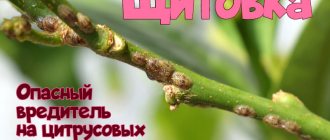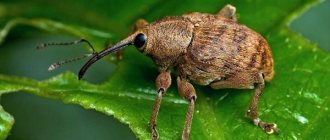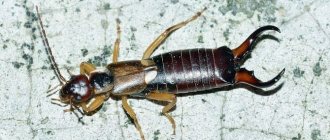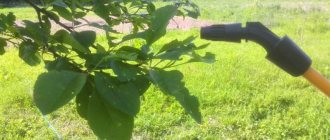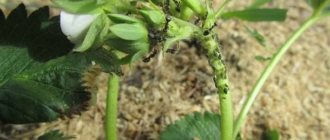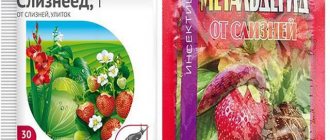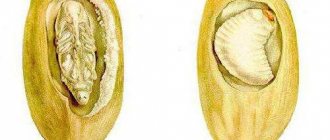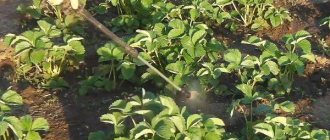Growing strawberries in the garden is not easy, and maintaining a harvest of fragrant berries is even more difficult. The most dangerous pest for it is a tiny weevil (photo above left), which destroys the buds, destroys the flower stalks of the crop and spoils the berries. Without fighting it, you can’t count on a good harvest.
Weevils appear on strawberries in late spring, when the plant begins its budding period. At this time, an invasion of a harmful beetle can reduce the future berry harvest by 2/3. A gardener needs to know how to treat strawberries against weevils, what preparations and remedies exist.
Dossier
Among the pests that ravage gardens and vegetable gardens, there are much more insidious and voracious ones. However, if you miss the moment, weevils can spread throughout the entire area and destroy 50-80% of the fruits.
Biological description
Weevils or elephant weevils are representatives of the large family Curculionidae, which unites 60 thousand species of beetles of different shapes, sizes and colors. Special feature: elongated head, reminiscent of an elephant trunk.
Females of Curculionidae lay eggs in plant tissue, using roots, stems, leaves, buds, and fruits for these purposes. There, as in an incubator, the larva grows and develops, eating the plant from the inside. Then pupation occurs. Thus, when the adult insect comes to the surface, the destruction process is already completed.
Types of pests
Among the elephant beetles that can seriously damage strawberry plantings, the following are especially common in Russia:
Raspberry-strawberry
The raspberry-strawberry weevil (lat. Anthonomus rubi) is an oval black insect with a long “proboscis” and thick light gray hairs on the body.
It is found in Siberia, Altai, and the European part of the country. The adult size is 2-3 mm. Causes noticeable damage to wild and garden strawberries, raspberries, blackberries, and rose hips.
While feeding and reproducing, it damages the aboveground organs of plants: leaves, stems, buds, ovaries. Overwinters on the remains of tops or nearby, in the soil. Most active from May to June.
Rough or turnip
The rough or turnip mower (lat. Otiorhynchus raucus) is a gray-brown beetle with an oval body 7 mm long.
The back is covered with sparse hairs, yellowish scales and raised tubercles. The “proboscis” is short, widening at the end, forming “blades” at the point where the antennae are attached.
Distributed everywhere, from the northern taiga to the southern steppes. The larva feeds on plant roots. Adults damage the tops and buds of various vegetable and fruit crops. Most active in cloudy weather. If you touch it, it falls and pretends to be dead.
Small black
The small black weevil (lat. Otiorhynchus ovatus) is a polyphagous pest.
Found in the European part of the country. It feeds on fruit and berry crops, beets, alfalfa, and young coniferous plants. The larvae destroy the root system.
The length of the beetle is 5mm. The body is oval, shiny, black or dark brown, covered with dotted grooves and short grayish hairs. The “proboscis” is thick and short. The paws and antennae are red-brown. During the day, the small mower hides and is active at dusk.
Alfalfa
The alfalfa beetle (lat. Otiorhynchus ligustici) is a rather large (12 mm), ovoid, dark-colored beetle.
The “proboscis” is short, thick, widening at the end. The color of the body is variable, but it is usually covered with silver-black scales and grayish-yellow hairs. It lives in the European part of Russia, the Caucasus and Southern Siberia.
It feeds on a wide variety of herbaceous plants and shrubs, but prefers hops, legumes and fruit crops. Adults damage leaves, flowers and buds. The larvae eat the roots. It is most active from May to July in the morning and evening hours.
Furrowed
The furrow mower (lat. Otiorhynchus sulcatus) is a polyphagous pest.
It feeds on industrial crops, berries, vegetables, grapevines and even ornamental plants. Adult insects eat leaves and buds. The larvae spoil the roots. Color black or dark brown. The body is covered with a dotted relief pattern with rows of golden spots. The “proboscis” is short, with a deep groove. The length of the beetle is 10 mm. They prefer to live in greenhouses, conservatories and nurseries.
Other types of polyphagous weevils also sometimes show interest in garden strawberries: they eat leaves and tendrils, undermine petioles and peduncles, and damage the root system.
Weevil on strawberry
The presence of a weevil in a garden plot is usually discovered too late and becomes an unpleasant surprise.
Elephant beetles appear unnoticed, act secretly, and the damage from their activity is irreparable: lush seedlings have withered, buds have fallen off, ovaries and young rosettes have died. To prevent this from happening, you need to recognize the pest in time.
Preventive measures
You can prevent the appearance of weevils on strawberries or minimize the damage they cause by timely prevention. It is easier to carry out than to fight a resilient beetle.
Recommendations:
- do not plant raspberries and blackberries near strawberry beds;
- plant varieties with a short flowering period;
- during spring and autumn digging, add ash to the soil;
- immediately remove dry leaves, stems, shoots;
- plant herbs with a pungent odor nearby;
- in the fall, remove plant residues, dry leaves, weeds from the site, treat the soil with folk remedies or biological preparations;
- Regularly weed and loosen the soil superficially.
In order not to miss the appearance of a beetle, you need to inspect strawberries and berry bushes daily. If it is detected in time, then fighting it will require less effort than with an overgrown population.
Photos of weevils
Methods for detecting strawberry weevil
Tracking down individual bugs is too time-consuming and pointless. Moreover, a weevil accidentally climbing into a strawberry bed will not cause much trouble. You have to be afraid of a colony of pests, but it doesn’t suddenly appear.
This is interesting! Elephant beetles are not adapted to long-distance migrations. Many species lack wings altogether, while others have them poorly developed. Insects spread by crawling from place to place or making short flights. They feed and hibernate near those plants that served as an “incubator” for the larvae.
Traces of a weevil colony should be looked for closer to autumn or early spring. When examining strawberry bushes, pay attention to the following signs:
Small round holes on the leaves . These are punctures that elephants make with their “proboscis” when they feed. When there are few beetles, the damage is almost invisible, but if the tops are dotted, it’s time to be wary.- Withered petioles and pedicels. They look like they weren't completely cut off with scissors. If mainly the peduncles are damaged, then the situation is bad - the raspberry-strawberry weevil has “worked” here.
- Dried, as if gnawed, edges of leaves , “bitten” petioles and antennae mean that a leaf or stem elephant has settled in the area.
- Individual wilting bushes or rosettes. You need to inspect the roots. Circular damage indicates the presence of a mower.
Adult beetles, larvae or pupae should be found in the ground next to the damaged plant.
Possible consequences
It is not difficult to combat isolated, small colonies of weevils.
But if you do not pay attention to the warning signs listed above, the beetles can multiply and deal a crushing blow to the gardening industry.
They won’t destroy all the strawberries, but it’s quite possible to lose half the harvest. However, these insects will not limit themselves to berries; they will also destroy other crops if they like them.
At the same time, they will move around the site and climb up to the neighbors, creating additional difficulties. In this case, getting rid of uninvited guests will require more than one year, great perseverance and a whole range of measures.
Features of the beetle and its harm
The biggest problem of the modern garden is the inability to control the weevil population, which in turn multiplies quickly and leads to the death of plants and crops, not disdaining shrubs and trees.
The pest lays eggs mainly in buds. After the larvae hatch, they actively eat the petals of the buds, which leads to a lack of harvest.
Adults feed on the foliage of strawberries, wild strawberries, tomatoes, peppers, and flowers, leaving behind wounds through which pathogenic flora penetrates the plant. Just a few families of weevils are enough to leave a strawberry plantation of 2 acres without a harvest. To do this, you just need to ignore the pest and create comfortable conditions for it in every possible way.
How to deal with weevils on strawberries
Comprehensive methods of combating weevils include the following measures:
- Agrotechnical – loosening and plowing of the soil, isolation of infected crops, crop rotation, destruction of plant residues.
- Biological - involve the use of natural insecticides or the attraction of natural enemies of the pest beetle (birds, ants, wasps) to the site.
- Chemical – use of inorganic products, treatment of seed, soil, etc.
- Mechanical - collecting or shaking off beetles.
Their use depends on the characteristics of the species attacking the area.
Important! It is impossible to get rid of beetles in any one way. Moreover, you should not rely solely on chemicals.
Folk remedies
Preparations that can be made at home are often preferable to complex chemical formulations.
Advantages
- affordability;
- safe for people, plants and pollinating insects;
- can be used regularly throughout the season;
- are easily washed off and do not accumulate in the soil.
Flaws
- the effect is not immediately noticeable and largely depends on weather conditions;
- Frequent repeated processing is required.
What to treat in the spring?
Infusions of tobacco, garlic (200 g per 10 l of water) or hot pepper (500 g per 10 l). These products are used during the formation of buds.- Infusion of celandine and onion peel (1:2). Fill a three-liter container with the mixture and fill one third with boiling water. Strawberries are sprayed at the stage of flowering and ovary formation.
- Decoctions of tansy, wormwood and mustard infusion with the addition of laundry soap (40 - 50 g of soap per 10 liters of liquid). It is used during the formation of buds.
- Solutions of boric acid, potassium permanganate, ammonia.
The effect is enhanced by mulching the beds with ash and dry pine needles. In spring, it is recommended to treat the soil with an iodine solution (half a teaspoon per bucket of water). You can also spray the bushes with a solution of mustard powder, learn more from the video below:
How to get rid of biological products and chemicals
Chemical methods are rarely used, but sometimes you cannot do without them. So for large-scale quarantine measures they use:
gas "Metabrom-RFO";- drug "Foscom" in tablets.
For local lesions, contact insecticides that are quite safe for humans are often used:
- "Decis";
- "Ram";
- "Iskra M"
- "Inta-vir".
However, such drugs kill not only weevils, but also beneficial pollinating insects and affect earthworms and birds.
Biopesticides are preferable because they act more specifically and provide excellent protection for a long time. These drugs contain microorganisms that attack pests. For example:
- "Iskra Bio" based on avermectins, which cause paralysis in elephant beetles;
- "Nemabakt", containing a predatory nematode capable of destroying mower larvae in the ground.
Biopesticides are absorbed by the plant without causing harm to it or the environment.
Attention! There are no varieties of garden strawberries that are absolutely resistant to the weevil. Any variety is affected, but to varying degrees.
When to treat
Weevils begin to be active when the temperature rises to +10 ° C, so before the onset of warm weather it is necessary to put the ridge in order: remove plant debris left over from the fall, old mulch, loosen the soil, apply fertilizers with nitrogen, and mulch with fresh material. For prevention, you can treat the seedlings and soil with bioinsecticides, folk remedies, Bordeaux mixture, and copper sulfate. The measures taken will reduce or eliminate the likelihood of the beetle spreading.
Related article:
How to spray a pear for scab
The following stages of treatment, both for preventive and therapeutic purposes, are carried out before and after flowering. If you do not have time to treat before flowering, it is difficult to destroy the pest that has settled in the buds and flowers.
After the berry picking is completed, the bushes are inspected, deformed leaves and thickened stems are removed. If the entire bush is suspicious, then it is better to tear it out and burn it, and treat the soil and other bushes with an insecticide with a broad spectrum of action.
Good to know: Rules for spring treatment of strawberries against pests
Ways to combat weevils. Table
In the table below we have collected for you the most effective methods of pest destruction. Both folk and chemical methods.
Table. Anti-weevil drugs
| Means | Preparation | Use / Frequency of treatments |
| Aktellik | 1 ampoule per 2 liters of water | Spray as needed. No more than 2 times with an interval of 3 weeks |
| Alatar | 5 ml of the drug per bucket of liquid | Spray as needed. No more than 2 times with an interval of 3 weeks |
| Biokill | Dilute 4 ml in 1 liter of water, then increase the volume of the working solution to 5 liters | No more than 2 treatments per season. Interval – 3 days |
| Wofatox | 10 grams of the drug per bucket of water | Treatment before flowering and after harvesting. No more than 2 sprays per season |
| Mustard-soap infusion | 200 grams of powder per bucket of water. Add finely grated soap for better adhesion | Spraying during budding |
| Yeast bait | Make traps from plastic bottles (cut off the neck). Pour the solution inside: 1 liter of water, 200 g of sugar, 100 g of fresh yeast. Coat the inside walls with vegetable oil | Place baits in the strawberry beds and clean them regularly |
| Ash | Grind charcoal or ash into powder | Sprinkle over strawberry beds (1 cup per square meter) |
| Intavir | 3 tablets per 10 liters of liquid | One-time treatment before flowering |
| Iodine water | 1 teaspoon of iodine per 10 liter bucket of water | Strawberries should be processed in March when the snow melts. |
| Spark Double Effect | Dilute 1 tablet in 10 liters of water | Consumption rate – 1.5 liters of working solution per hundred square meters |
| Datura infusion | Pour in 0.5 buckets of grass tops, add hot water, close the lid and leave to infuse for 2 days. | Spraying as needed |
| Onion peel infusion | Select a container (3 L, 5 L, 10 L) and fill it halfway with husks. Fill with water and leave for a day. Dilute the concentrate 1 to 1 with clean water | Treat every 5 days |
| Wormwood infusion | Fill a 5-liter container halfway with wormwood and add water. Boil for 5 minutes. Cool and add another 5 liters of water | Spraying as needed during budding |
| Capsicum infusion | Grind 0.5 kg of pepper and add 10 liters of water | Spraying during budding |
| Infusion of celandine and onion peel | In a 3 liter jar, mix crushed dried celandine and onion peels in a ratio of 1 to 2. Pour 1 liter of boiling water. | Treatment during flowering and ovary formation |
| Nemabact (Antonem) | 1 pack per 10 liters of water. Pour the preparation through a sieve. When watering or spraying, stir the working solution constantly | Application during the growing season |
| Tansy decoction | Pour 400 grams of dry tansy into 5 liters of water, leave for 2 days, and boil. Then increase the volume to 10 l and spray | Spraying during budding |
| Hellebore decoction | Pour 1 kg of tops with water and boil for half an hour. Increase the volume of working fluid to 10 l | Apply only after harvesting |
| Boric acid solution | 1/3 sachet (3 g) per bucket of water | Spraying during budding and ovary formation |
| Potassium permanganate solution | 5 grams of potassium permanganate per 10 liters of water. Leave for 2 days before use | Apply as needed |
| Ammonia solution | 1 bottle (50 ml) per bucket of water | Apply before flowering. After - only in cases of extreme infection |
| Peroxide solution | The working solution is prepared from 2-3 tablespoons of the drug per 1 liter of water | Treatment once every 7 days throughout the year |
| Fir oil solution | 2 tablespoons per bucket of water. For sticking, add half a bar of soap, grated on a fine grater. | Treatment is carried out before budding |
| Soda solution | 2 tablespoons of soda per 10 liters of water | Regularly, including during flowering |
| Chamomile solution | For 1 bucket of water you need about 1.5 hundred chamomile flowers. For better adhesion, add half a bar of soap | Process as needed |
| Tobacco infusion | Pour 200 grams of tobacco dust into a bucket of water | Spraying during budding |
| Vinegar solution | For 10 liters of water 100 ml 9% vinegar | Treat with fine spray |
| Fufanon | 1 ampoule per 5 liters of water | Processing during the growing season. The consumption rate of the drug is 5 liters per 10 square meters. m |
| Pine infusion | Pour 1.5 kg of pine needles into 10 liters of warm water. Strain before use | No more than 3 treatments |
| Garlic infusion | Grind 200 grams of garlic, add water and leave for a day. Dilute in 10 liters of water to prepare a working solution | Spraying during budding |
IMPORTANT! Treatment with pesticides must be stopped at least 5 days (in some cases 14) before harvest.
What means will help defeat this pest?
How should strawberries be treated against weevils during flowering? Gardeners use various means for this. Their arsenal includes both chemical preparations and biological and folk remedies.
The most popular chemicals include Admiral, Calypso, Alatar. Potent chemicals used include Karbofos and Metaphos. In hot weather, use the drug Iskra-Bio.
Prevention
The most common care measures will help prevent the appearance and uncontrolled reproduction of elephant beetles:
Timely weeding and destruction of old tops.- Compliance with strawberry growing technologies.
- Deep plowing of the soil in autumn.
- Regular updating of beds, mulching.
In addition, it is recommended to place strawberry plantings at the maximum possible distance from other plants that are of interest to the pest. Onions and garlic growing nearby will help protect the berries.

